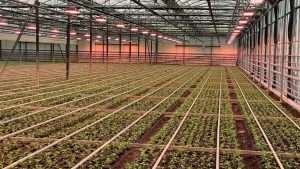The need to guarantee a production of flowers and vegetables throughout the year has been consolidated for many years and will be increasingly so in the future. The needs of the consumer and the advantages of the producer are many and we will not recall them as they are beyond the subject of these notes.
Let us just remember that to guarantee all this, greenhouses are not enough, but even if heated, it is in fact necessary to increase the scarce natural lighting, of the winter months, with artificial light. Until a few years ago the only solution were HPS lamps (high pressure sodium) to be clear the yellow lamps present in public lighting and which, little by little, are being replaced with LED lamps.
In crops, however, what is used is not all the light emitted by the lamps nor all that emitted by the Sun but only a part of it; in particular the frequencies of blue and red while green is rejected by almost 90%; this is why vegetation is green.
The advantage of LED in cultivation is therefore not only in the greater efficiency compared to other light sources but also in the ability to provide a specific light with a high content of blue and red. In practice, if the difference in luminous efficiency allows a 40% reduction in consumption, the ability of LED to provide a specific spectrum for photosynthesis and even for the type of crop, allows a further reduction in the power used by another 40% reaching values of 30-35% compared to traditional technologies.
In particular in flower cultivation, with LUXLED devices, 400W lamps can be replaced with 140-145W devices and 600W lamps with 220W devices, therefore with a drastic reduction in consumption.
Other advantages are then associated with LED, the main one being the life which on average is 4/5 times that of HPS lamps and this helps to compensate for the greater investments

